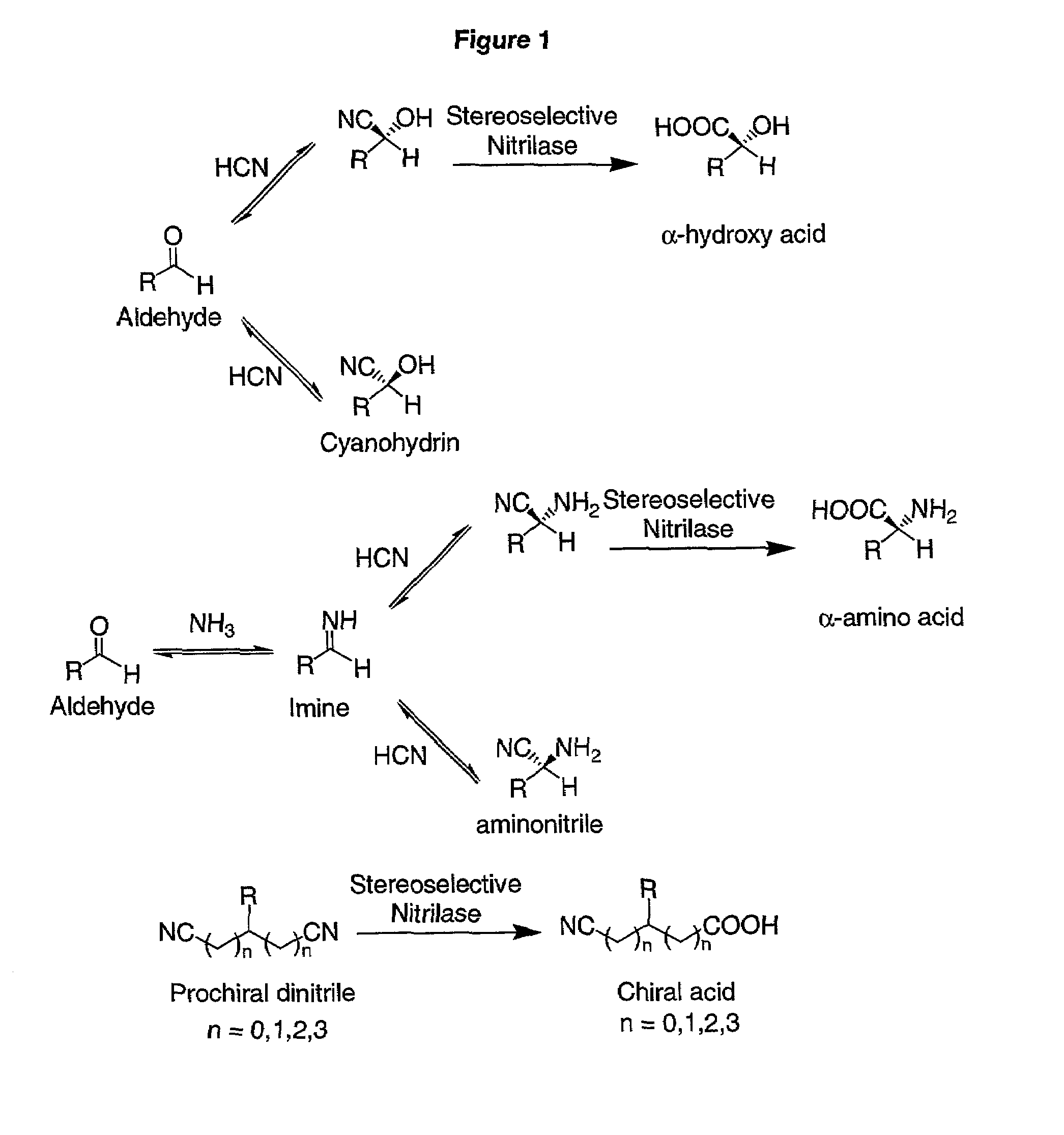Nitrilases and methods for making and using them
a technology of nitrilases and nitrile, which is applied in the field of molecular biology, biochemistry and chemistry, can solve the problems of preventing further transformation of nitrile thus obtained, and achieve the effect of improving the expression of polypeptides and altering biological activity
- Summary
- Abstract
- Description
- Claims
- Application Information
AI Technical Summary
Benefits of technology
Problems solved by technology
Method used
Image
Examples
example 1
Phagemid infections
[0307]For each library to be screened for nitrilases, an infection was set up as follows: 5 ml of an OD600 nm=1 resuspension of SEL700 cells and 1 ml of the phagemid library to be screened were combined. The combination was incubated in a 37° C. waterbath for 45 min.
[0308]Using the infection, serial dilutions were made in 10 mM MgSO4, using 10 μl aliquots of the infection.
[0309]
titer of librarydilutions to make~105 cfu / ml10−1 dilution~106 cfu / ml10−1, 10−2 dilution~107 cfu / ml10−1, 10−2, 10−3 dilution
[0310]60 μl of each of the following dilutions were deposited onto a small LB-kan50 plate:
[0311]
titer of librarydilutions to make~105 cfu / mlundiluted infection, 10−1 dilution~106 cfu / ml10−1, 10−2 dilutions~107 cfu / ml10−2, 10−3 dilutions
[0312]The cells in the infection were centrifuged in a tabletop centrifuge at 4° C., 4.6k rpm, 10 min to form pellets. The supernatant was decanted from the resulting pellets. The cells were resuspended in residual liquid. All of the resu...
example 2
Selection Screenings
[0313]The cells of each infection plate were resuspended with ˜4 mls 10 mM MgSO4. The resuspensions were placed in a tube. The remaining cells on each plate were resuspended with ˜3 mls 10 mM MgSO4 and combined with the first resuspension from the same plate. The volume of each tube was brought to 12 ml with 10 mM MgSO4, The tubes were vortexed vigorously. The tubes were centrifuged in a tabletop centrifuge at 4° C. and 4.6 k for 10 min to form pellets. The supernatant was decanted from each resuspension. The washed cells in each tube were resuspended with 10 ml 10 mM MgSO4. The resuspensions from each library were stored at 4° C. until the selection cultures were ready to be set up.
[0314]For each resuspension, selection cultures were set up using the following process:[0315]1) The nitrilase selection medium was prepared, using: 1XM9 medium with 0.2% glucose, no nitrogen and 50 μg / ml kanamycin (for pBK phagemid libraries only; use ampicillin for pBS libraries).[0...
example 3
Isolation of a Positive Nitrilase Clone from Selection Cultures
[0321]Ten (10) μl of selection culture with growth was streaked out onto a small LB-kan50 plate and allowed to grow for 2 nights at 30° C. Five isolated cfu were picked and each was grown in 2 ml nitrilase selection medium at 30° C. Each culture was monitored (where growth indicates positive cfu was picked), and was removed when monitoring indicated that it was in a stationary phase of growth. One (1) ml of culture was used to do a plasmid preparation and was eluted with 401 μl elution buffer. Five to eight (5-8) μl DNA was cut with Pst I / Xho I or Sac I / Kpn I restriction enzymes to remove insert from vector. A restriction fragment length polymorphism (RFLP) determination was carried out to identify the size of the insert. The insert was sequenced.
PUM
| Property | Measurement | Unit |
|---|---|---|
| Fraction | aaaaa | aaaaa |
| Fraction | aaaaa | aaaaa |
| Fraction | aaaaa | aaaaa |
Abstract
Description
Claims
Application Information
 Login to View More
Login to View More - R&D
- Intellectual Property
- Life Sciences
- Materials
- Tech Scout
- Unparalleled Data Quality
- Higher Quality Content
- 60% Fewer Hallucinations
Browse by: Latest US Patents, China's latest patents, Technical Efficacy Thesaurus, Application Domain, Technology Topic, Popular Technical Reports.
© 2025 PatSnap. All rights reserved.Legal|Privacy policy|Modern Slavery Act Transparency Statement|Sitemap|About US| Contact US: help@patsnap.com



